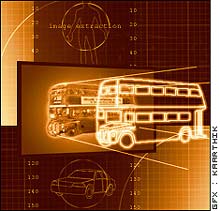Here you can find a summary of innovations in the fields of information and data processing and up-to-date developments on IT equipment and hardware.
This area covers topics such as IT services, IT architectures, IT management and telecommunications.

Joint news release of Infineon Technologies and IBM
IBM and Infineon Technologies AG (FSE/NYSE: IFX) today announced they have developed the most advanced Magnetic Random Access Memory (MRAM) technology to date by integrating magnetic memory components into a high-performance logic base.
Today’s announcement could accelerate the commercialization of MRAM, a breakthrough memory technology with the potential to begin replacing some of today’s memory technologies as early as

As any viewer of Crimewatch will know, E-fit pictures don’t always give a true likeness of a human face. However, all this is set to change thanks to researchers at the University of Kent who are working with their counterparts at the Open University to create a software system that will generate far more life-like, and therefore far more easily identifiable, faces.
Using a combination of computer science and forensic psychology, the team are developing a revolutionary system that will enabl

Expanding their successful business relation Siemens Information and Communication Mobile (FSE, NYSE: SIE), a leading provider of mobile phones, and Infineon Technologies (FSE, NYSE: IFX), a leading semiconductor supplier for secure mobile solutions, today announced that Siemens has chosen Infineon’s S-GOLD Family for their next generation of multimedia oriented GPRS and EDGE handsets.
Infineon’s chipset platforms for GPRS and EDGE handsets are based on S-GOLDlite and S-GOLD. Both platforms

Penn State researchers have developed new software that can help decision-making teams in combat situations or homeland security handle information overload by inferring teams’ information needs and delivering relevant data from computer-generated reports.
The agent software called CAST (Collaborative Agents for Simulating Teamwork) highlights relevant data. This helps improve a team’s decision-making process as well as enhances members’ collaboration.
“This version of C

Laptop computers can generate enough heat that, in rare cases, they actually catch fire. While engineers have a great grasp of how to control electrical charge in circuits, they have a hard time getting rid of the heat created by flowing electrons. What’s missing is a fundamental understanding of how individual electrons generate heat.
A new device developed by University of Wisconsin-Madison Electrical and Computer Engineering Associate Professor Robert Blick promises to change that.

Inflation’s got nothing to do with it. Since the beginning of time, a picture has always been worth more than a thousand words. But in this age of information proliferation, that reality is the taproot of a vexing problem that Zhongfei “Mark” Zhang, an assistant professor of computer science at Binghamton University, is determined to help solve.
From personal and commercial digital image libraries and multimedia databases to data mining programs and high-tech security and defense survei